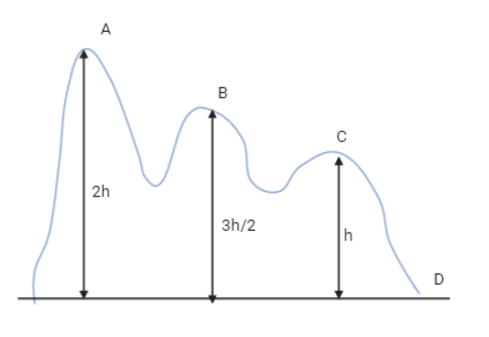Answer
416.7k+ views
Hint: The sum of potential energy and kinetic energy at point A is equal to the kinetic energy at point D. The potential energy at point D is zero. The height in the formula of potential energy is 2h.
Complete step by step answer:
The roller coaster possesses both potential and kinetic energy at point A because potential energy $\left( {P_1} \right)$ is due to its height from the ground and kinetic energy $\left( {K_1} \right)$ due to its speed. A potential energy is the energy possessed by the body due to its specific position, configuration, etc and kinetic energy is energy that a body has due to its motion.
Thus, initial sum of total energy $ = {P_1} + {K_1}$
When the roller coaster reaches at point D, it only possesses kinetic energy. Potential energy is zero because its height from the ground is zero. Let the final kinetic energy be ${K_2}$. Thus, final sum of total energy ${K_2}$.
According to the law of conservation of energy, the energy can neither be created nor destroyed but it can be transferred from one form to another form of energy i.e., the initial sum of total energy is equal to the final sum of total energy.
${P_1} + {K_1} = {K_2}$
$Mg\left( {2h} \right) + \dfrac{1}{2}M{u^2} = \dfrac{1}{2}M{v^2}$ where M is the mass of roller coaster, g is acceleration due to gravity, 2h is height of the coaster at point A from the ground, and v is the final speed at point D.
$M\left( {2gh + \dfrac{1}{2}{u^2}} \right) = \dfrac{1}{2}M{v^2}$
$\Rightarrow 2gh + \dfrac{1}{2}{u^2} = \dfrac{1}{2}{v^2}$
$\Rightarrow \dfrac{{4gh + {u^2}}}{2} = \dfrac{{{v^2}}}{2}$
$\Rightarrow 4gh + {u^2} = {v^2}$
$\Rightarrow v = \sqrt {4gh + {u^2}} $
Therefore, option C is correct.
Note: The roller coaster is moving with uniform motion as the friction between the roller coaster and the track on which it is moving is negligible and it always remains in contact with it. Therefore, the total energy is conserved.
Complete step by step answer:
The roller coaster possesses both potential and kinetic energy at point A because potential energy $\left( {P_1} \right)$ is due to its height from the ground and kinetic energy $\left( {K_1} \right)$ due to its speed. A potential energy is the energy possessed by the body due to its specific position, configuration, etc and kinetic energy is energy that a body has due to its motion.
Thus, initial sum of total energy $ = {P_1} + {K_1}$
When the roller coaster reaches at point D, it only possesses kinetic energy. Potential energy is zero because its height from the ground is zero. Let the final kinetic energy be ${K_2}$. Thus, final sum of total energy ${K_2}$.
According to the law of conservation of energy, the energy can neither be created nor destroyed but it can be transferred from one form to another form of energy i.e., the initial sum of total energy is equal to the final sum of total energy.
${P_1} + {K_1} = {K_2}$
$Mg\left( {2h} \right) + \dfrac{1}{2}M{u^2} = \dfrac{1}{2}M{v^2}$ where M is the mass of roller coaster, g is acceleration due to gravity, 2h is height of the coaster at point A from the ground, and v is the final speed at point D.
$M\left( {2gh + \dfrac{1}{2}{u^2}} \right) = \dfrac{1}{2}M{v^2}$
$\Rightarrow 2gh + \dfrac{1}{2}{u^2} = \dfrac{1}{2}{v^2}$
$\Rightarrow \dfrac{{4gh + {u^2}}}{2} = \dfrac{{{v^2}}}{2}$
$\Rightarrow 4gh + {u^2} = {v^2}$
$\Rightarrow v = \sqrt {4gh + {u^2}} $
Therefore, option C is correct.
Note: The roller coaster is moving with uniform motion as the friction between the roller coaster and the track on which it is moving is negligible and it always remains in contact with it. Therefore, the total energy is conserved.
Recently Updated Pages
Mark and label the given geoinformation on the outline class 11 social science CBSE

When people say No pun intended what does that mea class 8 english CBSE

Name the states which share their boundary with Indias class 9 social science CBSE

Give an account of the Northern Plains of India class 9 social science CBSE

Change the following sentences into negative and interrogative class 10 english CBSE

Advantages and disadvantages of science

Trending doubts
Which are the Top 10 Largest Countries of the World?

Difference between Prokaryotic cell and Eukaryotic class 11 biology CBSE

Fill the blanks with the suitable prepositions 1 The class 9 english CBSE

Differentiate between homogeneous and heterogeneous class 12 chemistry CBSE

How do you graph the function fx 4x class 9 maths CBSE

Select the word that is correctly spelled a Twelveth class 10 english CBSE

The Equation xxx + 2 is Satisfied when x is Equal to Class 10 Maths

Give 10 examples for herbs , shrubs , climbers , creepers

Change the following sentences into negative and interrogative class 10 english CBSE




